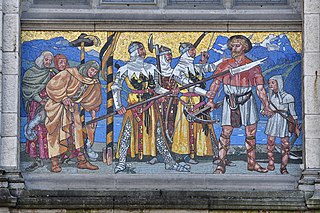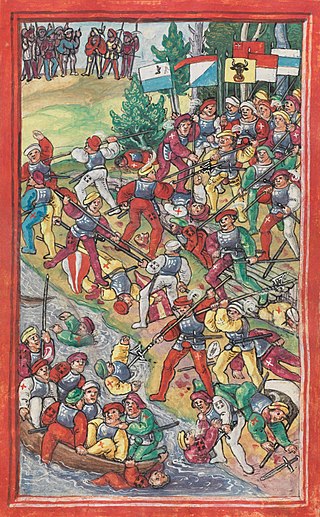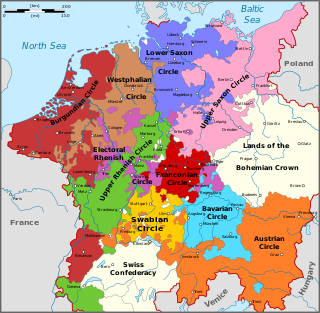Related Research Articles

Since 1848 the Swiss Confederation has been a federal republic of relatively autonomous cantons, some of which have a history of federation that goes back more than 700 years, putting them among the world's oldest surviving republics.

Unterwalden, translated from the Latin inter silvas(between the forests), is the old name of a forest-canton of the Old Swiss Confederacy in central Switzerland, south of Lake Lucerne, consisting of two valleys or Talschaften, now two separate Swiss cantons, Obwalden and Nidwalden.

The Federal Charter or Letter of Alliance is one of the earliest constitutional documents of Switzerland. A treaty of alliance from 1291 between the cantons of Uri, Schwyz and Unterwalden, the Charter is one of a series of alliances from which the Old Swiss Confederacy emerged. In the 19th and 20th century, after the establishment of the Swiss federal state, the Charter became the central founding document of Switzerland in the popular imagination.

William Tell is a folk hero of Switzerland. According to the legend, Tell was an expert mountain climber and marksman with a crossbow who assassinated Albrecht Gessler, a tyrannical reeve of the Austrian dukes of the House of Habsburg positioned in Altdorf, in the canton of Uri. Tell's defiance and tyrannicide encouraged the population to open rebellion and a pact against the foreign rulers with neighbouring Schwyz and Unterwalden, marking the foundation of the Swiss Confederacy. Tell was considered the father of the Swiss Confederacy.

The Old Swiss Confederacy began as a late medieval alliance between the communities of the valleys in the Central Alps, at the time part of the Holy Roman Empire, to facilitate the management of common interests such as free trade and to ensure the peace along the important trade routes through the mountains. The Hohenstaufen emperors had granted these valleys reichsfrei status in the early 13th century. As reichsfrei regions, the cantons of Uri, Schwyz, and Unterwalden were under the direct authority of the emperor without any intermediate liege lords and thus were largely autonomous.

Eidgenossenschaft is a German word specific to the political history of Switzerland. It means "oath commonwealth" or "oath alliance" in reference to the "eternal pacts" formed between the Eight Cantons of the Old Swiss Confederacy of the late medieval period, most notably in Swiss historiography being the Rütlischwur between the three founding cantons Uri, Schwyz and Unterwalden, traditionally dated to 1307. In modern usage, it is the German term used as equivalent with "Confederation" in the official name of Switzerland, Schweizerische Eidgenossenschaft, rendered Confédération and Confederazione in French and Italian, respectively. The related adjective, eidgenössisch, officially translated as Swiss federal, is used in the name of organisations, for example the Eidgenössische Technische Hochschule, Swiss Federal Institute of Technology. The term Eidgenosse refers to the individual members of the Eidgenossenschaft. It is attested as early as 1315, in the Pact of Brunnen, referring to the cantons of Uri, Schwyz and Unterwalden. The abstract noun Eidgenossenschaft is attested in the 15th century. In modern usage, Eidgenosse is sometimes used for "Swiss citizen", especially for those citizens of purely Swiss origin, not immigrated.

The Burgundian Wars (1474–1477) were a conflict between the Burgundian State and the Old Swiss Confederacy and its allies. Open war broke out in 1474, and the Duke of Burgundy, Charles the Bold, was defeated three times on the battlefield in the following years and was killed at the Battle of Nancy in 1477. The Duchy of Burgundy and several other Burgundian lands then became part of France, and the Burgundian Netherlands and Franche-Comté were inherited by Charles's daughter, Mary of Burgundy, and eventually passed to the House of Habsburg upon her death because of her marriage to Maximilian I, Holy Roman Emperor.

The Swabian War of 1499 (Alemannic German: Schwoobechrieg, called Schwabenkrieg or Schweizerkrieg in Germany and Engadiner Krieg was the last major armed conflict between the Old Swiss Confederacy and the House of Habsburg. What had begun as a local conflict over the control of the Val Müstair and the Umbrail Pass in the Grisons soon got out of hand when both parties called upon their allies for help; the Habsburgs demanding the support of the Swabian League, while the Federation of the Three Leagues of the Grisons turning to the Swiss Eidgenossenschaft. Hostilities quickly spread from the Grisons through the Rhine valley to Lake Constance and even to the Sundgau in southern Alsace, the westernmost part of the Habsburg region of Further Austria.

Albrecht Gessler, also known as Hermann, was a legendary 14th-century Habsburg bailiff at Altdorf, whose brutal rule led to the William Tell rebellion and the eventual independence of the Old Swiss Confederacy.

The Battle of Héricourt was fought on 13 November 1474 near Héricourt, Burgundy, as part of the Burgundian Wars. It resulted in victory for the Swiss Confederacy and its allies over the Burgundian State.

Melchior Russ was born of an old noble family in Lucerne.

The Rütli Oath is the legendary oath taken at the foundation of the Old Swiss Confederacy by the representatives of the three founding cantons, Uri, Schwyz and Unterwalden, It is named after the site of the oath taking, the RüWilliam Tell by Friedrich Schiller.

The Old Swiss Confederacy, also known as Switzerland, or the Swiss Confederacy was a loose confederation of independent small states, initially within the Holy Roman Empire. It is the precursor of the modern state of Switzerland.
The Chronicle of the City of Lucerne is the oldest existing chronological account of the history of the city of Lucerne.
The Urner Tellspiel is the earliest surviving written version of a William Tell play.

Shooting an apple off one's child's head, also known as apple-shot is a feat of marksmanship with a bow that occurs as a motif in a number of legends in Germanic folklore. In the Stith Thompson Motif Index it is F661.3, described as "Skillful marksman shoots apple from man's head" or "apple shot from man's head", though it always occurs in the form of the marksman being ordered to shoot an apple off his own son's head. It is best known as William Tell's feat.

The Tellskapelle is located on the Tellsplatte or Tellenplatte on the shore of Lake Lucerne at the foot of the Axenberg cliffs, in the Sisikon municipality, canton of Uri, Switzerland. It is across the Bay of Uri (Urnersee) from the Rütli, some 4.3 km away.

The transalpine campaigns of the Old Swiss Confederacy were military expeditions which resulted in the conquest of territories south of the Alps, corresponding more or less to the modern canton of Ticino, on the part of the Old Swiss Confederacy in the 15th and 16th centuries. These territories were known as ennetbirgische Vogteien or "transmontane bailiwicks".

When the Imperial Circles — comprising a regional grouping of territories of the Holy Roman Empire — were created as part of the Imperial Reform at the 1500 Diet of Augsburg, many Imperial territories remained unencircled.

The Stauffacherin is a Swiss legendary figure. According to Swiss folklore, she was the wife of Werner Stauffacher, the Landammann of the Canton of Schwyz and a founding father of the Old Swiss Confederacy. She was depicted in Friedrich Schiller's 1804 play William Tell as an advisor to her husband, advocating for Swiss independence from Habsburg rule. The image of the Stauffacherin, often viewed as the feminine counterpart to Wilhelm Tell, has become a symbol for Swiss national pride, democracy, and women's suffrage.
References
- Bergier, Jean-François. Wilhelm Tell: Realität und Mythos. München: Paul List Verlag, 1990.
- L. Tobler, Schweizerische Volkslieder; mit Einleitung und Anmerkungen (1882), pp. 1–5 (online edition, stanzas 1–9).
- E. L. Rochholz, Tell und Gessler in Sage und Geschichte. Nach urkundlichen Quellen (1877), pp. 180–187 (online edition, 35 stanzas).